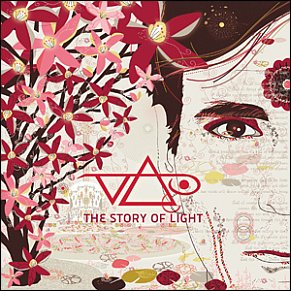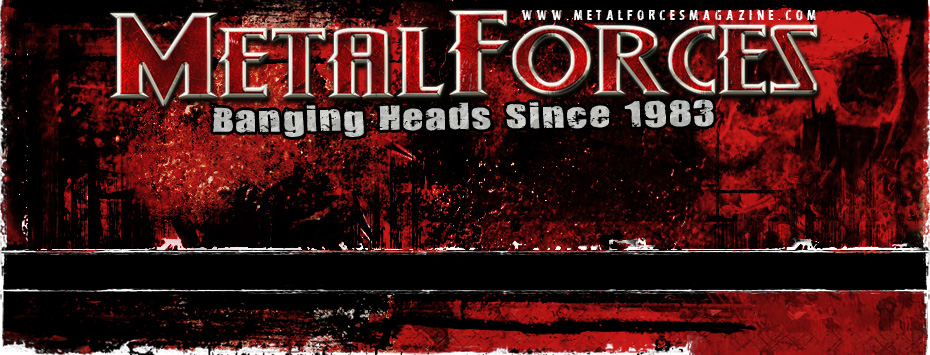
STEVE VAI – Vai The Revelator
Anthony Morgan
November 2012

|
Virtuoso guitarist Steve Vai issued sixth studio full-length Real Illusions: Reflections in February 2005, the first in a planned series of albums collectively chronicling a central tale. The series will form a trilogy at least, but perhaps as much as a quadrilogy. A gap of seven years separated the respective issues of Real Illusions: Reflections and its successor The Story Of Light, The Story Of Light arriving in August 2012 to be exact.
“I was looking to do a concept record, but maybe something a little unorthodox and contrary to typical concept records,” Steve remembers. “I had this story which is very kind of esoteric and in-depth. I thought ‘Why don’t I express the story over a series of records, like three records?’ In doing so, I decided to make the songs indicative of personalities, characters, and elements in the story. I didn’t want to give the story away though, so the songs are not in a particular order through the unfolding of the story.
“In order to figure out elements of the story, you need to read the liner notes and listen to some of the lyrics. It’s the kind of thing though where I’m not clobbering people over the head with the esoteric story when really all they wanna do is hear the music. After I release three records that are more or less installments of these songs for this story, I thought maybe perhaps at some point I would do a package of four records. I would take the three records that I would’ve previously released, and put the songs in the proper order. I’d maybe put some lyrics on the melodic songs, and release it with another record’s worth of narrative and maybe some additional songs. This way you can kind of listen to the story from the beginning to the end in a very linear fashion, and it would be completely different than the kind of instrumental records I usually make.”
The story in question concerns an individual “who goes through some horrific experiences. As such he goes mad, so we see the story through his eyes. He lives in this town, and in the town are people. Each person has an intricate story to their life, stories that you can’t even imagine. You can’t even write movies that have these types of stories, and at some point this shaman of sorts comes to the town. The people from the town go to this place; when they go into this place it’s like a big church, but it’s not a conventional kind of church. There’s this reflecting pond, and when a person looks into the reflecting pond what they see first is their identity.
“They see their reflection, and if they keep looking they start to see different layers of themselves. First, they identify with their identity. It’d be sort of looking at a mirror for a really long period of time, and what happens then is they start seeing how they’ve created their own identity. They start basically seeing how their identities were created by experiences in their life that they have a particular perspective of, and how their identities were an illusion in a sense. When they look deeper they see how these experiences in their life shaped their life, and how it affected the people around them in both good, bad, funny and all these different ways. They then even see deeper, and see how these actions of theirs have affected the world. You then start seeing the character development and stories that take place in this town that are pretty extraordinary. When they then look even deeper they start seeing into various past life experiences, and how they’re related to the kind of decisions that they’ve made in this particular life.
“They then look even deeper, and what eventually happens is they get to a point where they see that everything is basically an illusion – a form that changes – and underneath all of this form is pure consciousness. There’s only one of it, and it expresses itself in the physical in infinite forms. When Captain Drake Mason looks into the pond – the main character – he doesn’t see anything, or it seems like he doesn’t see anything. What he does is he leaves, and writes a book. At the end of the whole story is a scene where he presents this book to the town’s people, and the name of the book is Under It All. The first chapter is called The Story Of Light, and that’s how the story begins.”

|
Title cut and opening number ‘The Story Of Light’ includes Russian lyrics. “I had the track, and I had the lyrics which were the first chapter for The Story Of Light,” the axeman explains. “I didn’t wanna have it sung; there is a melody that works with the vocals, but I thought of having it recited. English just didn’t work – languages have different dynamics. I thought of Italian, but Italian is a very romantic language. It sounds like music, and something like French is very romantic sounding as well. German has a lot of sharp edges, but I tried to think of a language that would fit really well. I’ve always been attracted to the Russian language because it has a softness, but it has edges. I just thought that it would work really well. I did it, and I thought it worked really well.”
‘John The Revelator’, meanwhile, can trace its origins in the 1930 composition of the same name by American blues artist Blind Willie Johnson. “I have this collection of records called The Anthology Of American Folk Music (1952), which is all these very early Americana recordings,” Steve discloses. “I don’t go any place without them. There’s this one artist on there called Blind Willie Johnson doing this version of ‘John The Revelator’, and I was totally captivated by it. I studied this guy, and got all of his music. Whenever I would listen to his version of ‘John The Revelator’, I would hear it with all of these grandiose guitars and a really powerful lead singer. The song that follows it is called ‘Book Of The Seven Seals’. They were actually one piece of music, and it was all ‘John The Revelator’. I was just seeing this scene in the story almost theatrically, and I was juxtaposing together these different textures of gospel, but not real gospel.
“The second part of the song – ‘Book Of The Seven Seals’ – has this huge choir on it, like an 80-piece choir, and the arrangement is very hokey sounding. I was hearing this in my head, and so I built the track. When it came time to do the lead vocal, I was thinking of singing it myself. I know my limitations, and I probably would’ve destroyed the song. The next day though, I was at the Grammy Foundation’s 14th Annual Music Preservation Project (on February 9th, 2012) and Beverly McLellan took to the stage. I saw her sing for the first time, and I was completely blown away. I was astounded by this connection she has for soul. I said ‘That’s my singer for ‘John The Revelator’,’ and I was lucky enough that she accepted the invitation.”
Signalling The Story Of Light’s most emotional piece (as is customary on all Steve Vai full-length records), track seven happens to be a rendition of the old Celtic lullaby ‘Mullach A’tSi’. “I really like Celtic music,” the musician enthuses. “I have this one record called Celtic Lullaby (1998), and one of the tracks on there is ‘Mullach A’tSi’ by the singer Padraigin Ni Uallachain. When you listen to cultural music, the people that create it are absorbed in their culture. As a result, they approach music very differently than Western musicians. There are all these nuances of timing and articulation and dynamics and harmonic structures that are very different.
“As a musician my ear can pick up on these parameters, and the way she was singing had beautiful little nuances in it of phrasing that I wanted to do on the guitar. It was really hard; it was almost like re-learning how to play, but it was a glorious project for me. I had to focus really hard on each phrase – there are really specific nuances. Most people may not hear them, but somebody that’s really interested in guitar phraseology might get a kick out of it. So, that’s what I did. It’s a great way to expand your vocabulary.”
‘No More Amsterdam’ was co-penned with singer-songwriter Aimee Mann. “I was going to Berklee College Of Music, and so was Aimee – we actually went to school at the same time,” Steve recalls. “We even lived in the same apartment building, just a couple of doors away from each other. My girlfriend (Pia Maiocco) at the time – who’s now my wife – was Aimee’s best friend, so through the years I always had Aimee’s music in the house. Whenever she released something, I really liked it. I had this song called ‘Innerness’, and it was this beautiful kind of acoustic track. I wanted it to depict in the story as being sung by two people, a man and a woman. What it is is one guy looking at the reflecting pond, and he sees this guardian angel so to speak, the voice of better judgement. He has a conversation with them. I wrote the first line, and I just got this writer’s block. That told me I needed to do something else.

|
“I told my wife Pia about it, and she said ‘Why don’t you call Aimee?’ At first I thought ‘Steve Vai and Aimee Mann? That’s pretty contrasting music.’ I love what she does though. She’s like a poet, and her voice is always so powerfully confident. The song was sweet enough that I thought maybe she would take an interest, so I reached out to her and she really liked it. It was such a beautiful experience to work with her; I very, very rarely collaborate, but that was a beautiful collaboration. She came over, and we talked about it. She wrote all of the lyrics, and she named it ‘No More Amsterdam’. It all resonates very well with the story, because I explained to her what the story was about. She decided she would sing it, and it was really sweet. It turned out really nice.”
As far as the concept’s third installment is concerned, no concrete plans exist at the time of writing. “I have music written and I have certain storylines structured, but I don’t think it’s gonna be my next studio record,” the guitarist admits. “There are some other projects I wanna do, and I wanna evolve my own awareness of things that I’m interested in in life before I really tackle it. If it’s in my cards to live long enough, I hope to get to it (laughs). The final project is actually a quadrilogy.”
Live performances are scheduled in support of The Story Of Light, a United Kingdom trek beginning on December 1st at Portsmouth’s Guildhall. A date at Manchester’s Apollo on December 7th will conclude Steve’s visit to British shores. “It’s got a different dynamic than my other tours,” he reckons. “I always like to switch up the band a bit to give it a different feel. In my last band I had two violinists which works very well, and with this band I’m thinking of adding something different. I came across this electric harpist named Deborah Henson-Conant, and she plays this electric harp. It’s quite a sight to see. We can process the sound, and do some very interesting things with it. In my mind I thought it would work, but I didn’t think it was gonna work as good as it does (laughs). It’s really beautiful.
“When I put a show together, I really see myself as trying to be the best entertainer I can be. People spend their money and time to come to see a show, and I want to give them something as fulfilling as I can muster. As a result, the show has a flow to it that I think has a lot of different dynamics. There are really intense, dense, complex pieces, and very simple, stripped down pieces. At times it’s very heavy, and at times it’s very, very intimate and delicate. We do an acoustic set that has a nice feel to it. I don’t like to take myself too seriously, so there’s some comic relief here and there. Ultimately though, I also want people to feel that they sense great musicianship, so everybody in the band is very competent. My goal is to put on the best show that I can so that when people leave, they feel really good.”
The Story Of Light was released as an exclusive covermount CD via Classic Rock magazine on August 14th, 2012, and subsequently on September 11th through Favored Nations Entertainment.
Interview published in November 2012





